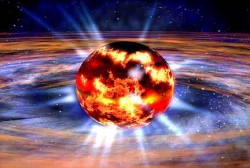C reative
Particle
Higgs
CPH Theory is based on Generalized light velocity from energy into mass.
CPH Theory in Journals
|
Measuring the Structure and Temperature of a Quiescent Neutron Star
|
|
So how do you take the temperature of one of the most exotic objects in the Universe? A neutron star (~1.35 to 2.1 solar masses, measuring only 24 km across) is the remnant of a supernova after a large star has died. Although they are not massive enough become a black hole, neutron stars still accrete matter, pulling gas from a binary partner, often undergoing prolonged periods of flaring.
Accretion can cause neutron stars to flare violently Fortunately, we can observe X-ray flares (using instrumentation such as Chandra), but it isn't the flare itself that can reveal the temperature or structure of a neutron star.
At the AAS conference last week, details about the results from
an X-ray observing campaign of MXB 1659-29, a quasi-persistent
X-ray transient source (i.e. a neutron star that flares for long
periods), revealed some fascinating insights to the physics of
neutron stars, showing that as the crust of a neutron star
cools, the crustal composition is revealed and the temperature
of these exotic supernova remnants can be measured… So why is this important? After a long period of X-ray flaring, the crust of a neutron star will heat up. However, it is thought that the core of the neutron star will remain comparatively cool. When the neutron star stops flaring (as the accretion of gas, feeding the flare, shuts off), the heating source for the crust is lost. During this period of "quiescence" (no flaring), the diminishing X-ray flux from the cooling neutron star crust reveals a huge wealth of information about the characteristics of the neutron star.
The cross section of a neutron star During quiescence, astronomers will observe X-rays emitted from the surface of the neutron star (as opposed to the flares), so direct measurements can be made of the neutron star. In his presentation, Cackett examined how the X-ray flux from MXB 1659-29 reduced exponentially and then levelled off at a constant flux. This means the crust cooled rapidly after the flaring, eventually reaching thermal equilibrium with the neutron star core. Therefore, by using this method, the neutron star core temperature can be inferred.
Including the data from another neutron star X-ray transient KS 1731-260, the cooling rates observed during the onset of quiescence suggests these objects have well-ordered crustal lattices with very few impurities. The rapid temperature decrease (from flare to quiescence) took approximately 1.5 years to reach thermal equilibrium with the neutron star core. Further work will now be carried out using Chandra data so more information about these rapidly spinning exotic objects can be uncovered. Suddenly, neutron stars became a little less mysterious to me in the 10 minute talk last Tuesday, I love conferences… Related publications:
1 2 3 4 5 6 7 8 9 10 Newest articles
|
|
Sub quantum space and interactions from photon to fermions and bosons |
Interesting articles
Since 1962 I doubted on Newton's laws. I did not accept the infinitive speed and I found un-vivid the laws of gravity and time.
I learned the Einstein's Relativity, thus I found some answers for my questions. But, I had another doubt of Infinitive Mass-Energy. And I wanted to know why light has stable speed?


